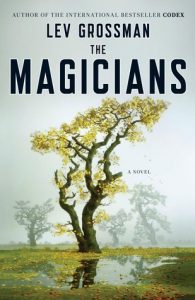 Was it magic or serendipity that a copy of The Magicians by Lev Grossman showed up in my local Little Free Library the very same week that the related Syfy series showed up on Netflix? I’m not certain, but I can say that reading the book while binge watching the series has me a little convinced that there is magic in the world around me, even if my Popper finger movements haven’t yet led to the dishwasher loading itself. It’s rare that I like an adaptation as much as the book, but experiencing the two together has added a whole new layer of enjoyment to the story and characters for me.
Was it magic or serendipity that a copy of The Magicians by Lev Grossman showed up in my local Little Free Library the very same week that the related Syfy series showed up on Netflix? I’m not certain, but I can say that reading the book while binge watching the series has me a little convinced that there is magic in the world around me, even if my Popper finger movements haven’t yet led to the dishwasher loading itself. It’s rare that I like an adaptation as much as the book, but experiencing the two together has added a whole new layer of enjoyment to the story and characters for me.
The World We Know
The story of The Magicians revolves around a school (Brakebills) that trains magicians and a series of children’s books about a magical place in the back of a cupboard called Fillory. While it would be easy to dismiss The Magicians immediately as derivative of Harry Potter and The Lion, the Witch, and the Wardrobe, given time Lev Grossman builds his own rich story around these elements. And though even more derivative elements crop up in the one season of the series that I’ve watched, I was always interested enough in Grossman’s characters to shrug it off.
Sequences Out of Time
The TV series and the book (books, really, The Magicians is the first book of a trilogy) are a wonderful case study of how to adapt literature to screen. Apparently this adaptation was done with the help of the author, something I credit with the success of the show, but I’ve seen authorial involvement go as badly as The Magicians goes well. There are notable differences: in the books, Brakebills is a college, on TV it’s a grad school; some of the characters have different names; some of the characters from the books don’t exist in the series; one of the characters from the series barely exists in the book; the timeline in the book is much elongated; etc.
What’s gorgeous about experiencing these two together, though, is the times that they do intersect. I think that’s because are fully realized in their own rights. Yes, there were moments of the series that made a lot more sense when I realized that the characters were originally fresh out of high school, but overall I liked that the series has a little more tooth because of the adult characters and that the books are more innocent. What I liked even more, though, was that I felt like I was having my own Fillory experience where life (TV) would go on every night as we watched episode after episode and a few days later I’d encounter spots in the books (Fillory) where the action overlapped with the series.
Fluid Sexuality
One thing that’s remarkable about the generation after mine is how much more fluid their idea of gender is—both in their norms and in who they love—and I appreciate how this was reflected in The Magicians. It’s more obvious in the series, but the source material certainly exists in the book. It’s something I enjoyed about Sense8 as well, until the writers threw away a perfectly good story in favor of scene after scene of pan-sexual orgies. I’m not opposed to depictions of the latter, but please don’t take away my story. The Magicians does a much better job of incorporating the human sexuality of a gender-fluid generation into the context of the story.
Book or Series?
Let’s be honest, time is short now that I’m a mom and I’m choosier than ever about what I read. But I still watch a couple hours of TV a night because I can sit next to my husband and share an experience without applying too much mental effort.
Whereas I ran through the show as fast as possible given the above schedule, if I hadn’t had a couple of holidays and a sick day, I might not have finished the book at all. I really appreciated the compressed timeline of the series when compared to the somewhat lagging action of the book (especially after Quentin leaves Brakebills). I appreciate that it’s difficult to portray creative malaise and a post-grad slump in print, but it’s much harder to read a slow portrayal of said malaise.
I’m excited to see the next season of the show, too, because there were aspects of Fillory that I think will translate better to screen. In the books there are all these mishmashed chimeras that were underdeveloped and felt pretty throwaway. Plus, one of my favorite characters (no hints!) disappeared for far too long in the book.
As I said, I’m glad that Lev Grossman was involved in the adaptation. I think he might be a better screenwriter than a novelist and I don’t think I’ll read the next in the series.
To make up your own mind about The Magicians, pick up a copy from Bookshop.org. Your purchase keeps indie booksellers in business and I receive a commission.
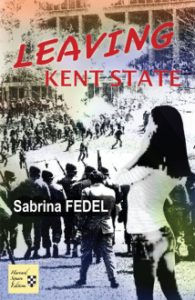 It’s inauguration day! Regardless of how you feel about the outcome of the election, I’m willing to bet your feelings are strong. Mine are and I’m so glad Leaving Kent State by Sabrina Fedel entered my heart and my home when it did because it made me less scared to stand up for my beliefs and turned me into a better human overall.
It’s inauguration day! Regardless of how you feel about the outcome of the election, I’m willing to bet your feelings are strong. Mine are and I’m so glad Leaving Kent State by Sabrina Fedel entered my heart and my home when it did because it made me less scared to stand up for my beliefs and turned me into a better human overall.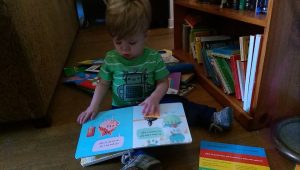
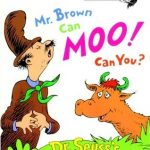 The rhythms of this book are fantastic. It’s a lot of fun to read aloud and I think my poetry has gotten better as a result. Making animal sounds is supposed to be a good way to help kids learn language and Remy seems to love when I dig in next to his ear and announce, “BOOM BOOM BOOM Mr. Brown is a wonder. BOOM BOOM BOOM Mr. Brown makes thunder.”
The rhythms of this book are fantastic. It’s a lot of fun to read aloud and I think my poetry has gotten better as a result. Making animal sounds is supposed to be a good way to help kids learn language and Remy seems to love when I dig in next to his ear and announce, “BOOM BOOM BOOM Mr. Brown is a wonder. BOOM BOOM BOOM Mr. Brown makes thunder.”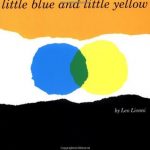 This is one of the books the library very wisely allows parents to take out on loan permanently. We all know what kids can do to books. No one wants them back after they’ve been out on loan. But the book is terrible. Little Blue leaves the house when his mama tells him not to (after she’s left him home alone). He and his friend Little Yellow cry so hard that they meld identities and their parents no longer recognize them. The illustrations appear to be made of torn paper. I don’t know why I keep reading it to my son.
This is one of the books the library very wisely allows parents to take out on loan permanently. We all know what kids can do to books. No one wants them back after they’ve been out on loan. But the book is terrible. Little Blue leaves the house when his mama tells him not to (after she’s left him home alone). He and his friend Little Yellow cry so hard that they meld identities and their parents no longer recognize them. The illustrations appear to be made of torn paper. I don’t know why I keep reading it to my son.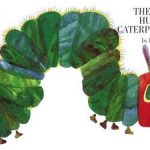 Torn paper done right. I still vaguely remember doing kindergarten projects with tissue paper in imitation of Carle’s iconic style and was delighted when my husband wanted to buy a copy that came with a little stuffed caterpillar for our little baby. Though the sentences are a little long and meandering, I love the focus on days of the week and counting and the story’s good. Even if it makes me want ice cream cones. We used to read the book with the caterpillar weaving in and out of the holes in the pages. But now Remy’s all business and I have to hurry if I want to get to the end. Bonus Eric Carle book is the aforementioned Brown Bear—talk about rhythm and I think the repetition is really good for language learning. I was dreading the day someone would tell me I look like the teacher in the book. It happened. I lived.
Torn paper done right. I still vaguely remember doing kindergarten projects with tissue paper in imitation of Carle’s iconic style and was delighted when my husband wanted to buy a copy that came with a little stuffed caterpillar for our little baby. Though the sentences are a little long and meandering, I love the focus on days of the week and counting and the story’s good. Even if it makes me want ice cream cones. We used to read the book with the caterpillar weaving in and out of the holes in the pages. But now Remy’s all business and I have to hurry if I want to get to the end. Bonus Eric Carle book is the aforementioned Brown Bear—talk about rhythm and I think the repetition is really good for language learning. I was dreading the day someone would tell me I look like the teacher in the book. It happened. I lived.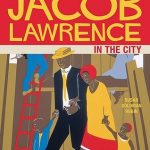 Arty parents trying to expose their kids to arty books can’t really go wrong with this book. The author does a good job of incorporating a blues rhythm into the text and I enjoyed getting to know more of Lawrence’s work. There’s also a book in this series that uses Magritte’s work that is more imaginative but the text and images in the Lawrence book work better together overall.
Arty parents trying to expose their kids to arty books can’t really go wrong with this book. The author does a good job of incorporating a blues rhythm into the text and I enjoyed getting to know more of Lawrence’s work. There’s also a book in this series that uses Magritte’s work that is more imaginative but the text and images in the Lawrence book work better together overall. Speaking of arty books, I adore Tullet’s books. I sometimes fantasize about my husband becoming a childrens’ book illustrator and these books feed that fantasy. This one doesn’t have any words, but it’s filled with abstract illustrations cut at odd angles and I like seeing what picture Remy will make with it next. You may have heard of Press Here which is a super fun book to read and I think will get better as Remy gets older. My least favorite Tullet so far is The Game of Red, Yellow and Blue. The color combinations are okay and I like the shape cutouts, but the “Fab-racadabra” rainbow carnival at the end does not translate well into English.
Speaking of arty books, I adore Tullet’s books. I sometimes fantasize about my husband becoming a childrens’ book illustrator and these books feed that fantasy. This one doesn’t have any words, but it’s filled with abstract illustrations cut at odd angles and I like seeing what picture Remy will make with it next. You may have heard of Press Here which is a super fun book to read and I think will get better as Remy gets older. My least favorite Tullet so far is The Game of Red, Yellow and Blue. The color combinations are okay and I like the shape cutouts, but the “Fab-racadabra” rainbow carnival at the end does not translate well into English.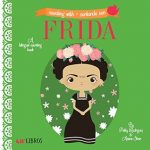 One of the things I’ve been trying to make sure Remy gets is exposure to other languages. I started reading him Garcia Lorca really early on and when I saw this adorable little book, I thought it would be a good chance to learn to count and for me to get my tongue around Spanish in ways that we could both practice. The illustrations are so attractive and I liked the book so much that we now have all of the books in the series. Probably the second best is Lucha Libre Anatomy/Anatomia and not just because I like shouting “ombligo!” on the belly button page.
One of the things I’ve been trying to make sure Remy gets is exposure to other languages. I started reading him Garcia Lorca really early on and when I saw this adorable little book, I thought it would be a good chance to learn to count and for me to get my tongue around Spanish in ways that we could both practice. The illustrations are so attractive and I liked the book so much that we now have all of the books in the series. Probably the second best is Lucha Libre Anatomy/Anatomia and not just because I like shouting “ombligo!” on the belly button page.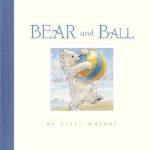 This is another book I liked so much that I bought everything else by Cliff Wright I could find. It’s a very simple book with just a couple of words on each page that match the illustration. Still, Wright achieves a kind of story with the pictures and I love the summary at the end where you can see all the pages at once. The rhyming is nice, too.
This is another book I liked so much that I bought everything else by Cliff Wright I could find. It’s a very simple book with just a couple of words on each page that match the illustration. Still, Wright achieves a kind of story with the pictures and I love the summary at the end where you can see all the pages at once. The rhyming is nice, too.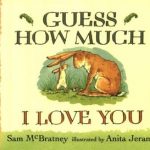 I knew this book was a classic and I loved the sentiment of not being able to quantify the amount of love a parent has for a child. What I wasn’t prepared for is how competitive it is. Geez Big Nutbrown Hare, just let your kiddo have the upper hand one time fer Chrissakes.
I knew this book was a classic and I loved the sentiment of not being able to quantify the amount of love a parent has for a child. What I wasn’t prepared for is how competitive it is. Geez Big Nutbrown Hare, just let your kiddo have the upper hand one time fer Chrissakes. One of the wonderful things about having a community of people around you when you have a baby is that they expose you to new things. I’ve always resisted Native American art because I didn’t understand it. But a Native friend gave this book to us at a baby shower and I love learning about the iconography of Native Northwest coast tribes and also some of the lore that accompanies it. Like the books says, “Raven teaches us to be clever and creative” and I’m really glad my son will have some exposure to a culture that’s very important in the area he calls home.
One of the wonderful things about having a community of people around you when you have a baby is that they expose you to new things. I’ve always resisted Native American art because I didn’t understand it. But a Native friend gave this book to us at a baby shower and I love learning about the iconography of Native Northwest coast tribes and also some of the lore that accompanies it. Like the books says, “Raven teaches us to be clever and creative” and I’m really glad my son will have some exposure to a culture that’s very important in the area he calls home.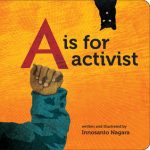 Some books are written for parents. This is one of them. I’m a socialist. I’d love for my son to be politically involved and try to make the world he lives in a better place. I don’t often read him this book, though, because there are a few things I need to teach him before he absorbs messages like “No! No! No! Yes to what we want. No to what must go.”
Some books are written for parents. This is one of them. I’m a socialist. I’d love for my son to be politically involved and try to make the world he lives in a better place. I don’t often read him this book, though, because there are a few things I need to teach him before he absorbs messages like “No! No! No! Yes to what we want. No to what must go.”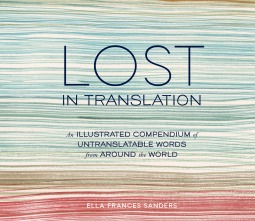 There are a lot of reasons I haven’t blogged lately. Only one of them is that I’ve been having trouble finding the right book. I don’t have enough to say about my troubled relationship with Winnie the Pooh or a deep enough understanding of Taoism to make my thoughts on The Te of Piglet worth sharing. The random thoughts that catch my attention in Nobody’s Home aren’t concrete enough to justify me blogging about Ugrešić
There are a lot of reasons I haven’t blogged lately. Only one of them is that I’ve been having trouble finding the right book. I don’t have enough to say about my troubled relationship with Winnie the Pooh or a deep enough understanding of Taoism to make my thoughts on The Te of Piglet worth sharing. The random thoughts that catch my attention in Nobody’s Home aren’t concrete enough to justify me blogging about Ugrešić 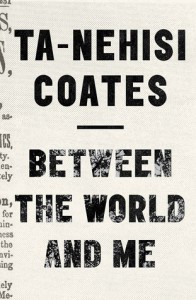 When a dear friend sent me a copy of Between the World and Me by Ta-Nehisi Coates, he said it was because I had a son. I don’t think I would have read the book if I’d understood it was about race in American society. But that skirting of uncomfortable topics is exactly why I needed to read this book. It’s why I think everyone should read this book.
When a dear friend sent me a copy of Between the World and Me by Ta-Nehisi Coates, he said it was because I had a son. I don’t think I would have read the book if I’d understood it was about race in American society. But that skirting of uncomfortable topics is exactly why I needed to read this book. It’s why I think everyone should read this book.